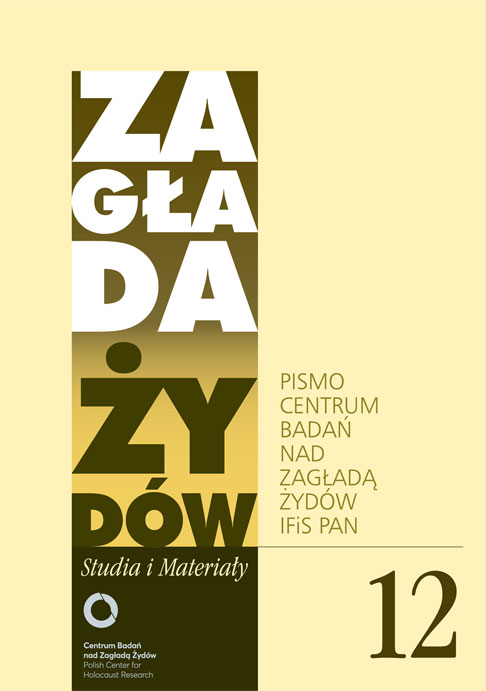Frankenstein w warszawskim getcie. Historia i legenda
Zagłada Żydów. Studia i Materiały, Nr 12 (2016), Strony: 187-208
Data zgłoszenia: 2020-10-19Data publikacji: 2016-11-30
 https://doi.org/10.32927/ZZSiM.414
https://doi.org/10.32927/ZZSiM.414
Abstrakt
The article deals with one exceptionally violent German perpetrator who was part of the occupation force in Warsaw during the Second World War. Inside the Ghetto he maltreated and killed a large number of women, children and men for his own personal pleasure. He did this to such an extensive degree that the population perceived him as monstrous being that was given the nickname „Frankenstein”. The article is mainly based on statements in juridical investigations, from the victim as well as from the perpetrator perspective, supplemented with some selected additional sources. Firstly the source corpus will be evaluated, to work out how these historical sources can be used to shed light on „Frankenstein”. This will be followed by an analysis of the actual identity of this perpetrator. It will be shown that he was, contrary to common belief, not necessarily the SS-Rottenführer Josef Blösche but more likely a member of the German Police Battalion 61. In the end the question will be also raised of how it was possible – despite all rules and regulations – that ghetto guards like him behaved like a marauding soldiery.
Słowa kluczowe
getto warszawskie , Zagłada , policja umundurowana , zbrodnie okupacyjne , warty w getcie , batalion policyjny , sprawca , przemoc , strach , terror , życie w getcie
Licencja
Prawa autorskie (c) 2016 Autor&"Zagłada Żydów. Studia i Materiały"

Utwór dostępny jest na licencji Creative Commons Uznanie autorstwa 4.0 Międzynarodowe.
https://creativecommons.org/licenses/by/4.0
Czasopismo publikowane jest w standardzie Diamond Open Access na licencji CC-BY-4.0 Deed - Uznanie autorstwa 4.0 Międzynarodowa - Creative Commons
Podobne artykuły
- Israel Gutman, Artur Eisenbach: historyk i pracownik Żydowskiego Instytutu Historycznego , Zagłada Żydów. Studia i Materiały: Nr 3 (2007)
- Jerzy Mazurek, Alina Skibińska, “Barwy Białe” on their Way to Aid Fighting Warsaw. The Crimes of the Home Army against the Jews , Zagłada Żydów. Studia i Materiały: Nr Holocaust Studies and Materials (2013)
- Redakcja ., Od redakcji , Zagłada Żydów. Studia i Materiały: Nr 15 (2019)
- Zofia Wóycicka, Zachować decorum. Nowa ekspozycja stała w Muzeum i Miejscu Pamięci w Sobiborze , Zagłada Żydów. Studia i Materiały: Nr 17 (2021)
- Magdalena Semczyszyn, Żydzi w sowieckich oddziałach partyzanckich na północno-wschodnich terenach Drugiej RP 1941–1944 – zarys problematyki , Zagłada Żydów. Studia i Materiały: Nr 17 (2021)
- Marta Duch-Dyngosz, W poszukiwaniu lokalnej pamięci o Zagładzie. Przypadek upamiętniania społeczności żydowskich w mniejszych miejscowościach we współczesnej Polsce , Zagłada Żydów. Studia i Materiały: Nr 17 (2021)
- Michał Kowalski, Na polach Treblinki. Profanacja terenów po obozie śmierci w świetle relacji i dokumentów , Zagłada Żydów. Studia i Materiały: Nr 17 (2021)
- Tomasz Sierwierski, Feliks Tych. Historyk (ocalały z) Zagłady , Zagłada Żydów. Studia i Materiały: Nr 17 (2021)
- Katarzyna Chmielewska, Pamięć wielokierunkowa i agoniczna a polityka pamięci , Zagłada Żydów. Studia i Materiały: Nr 17 (2021)
- Krystyna Hartman, Tak niewiele wiem [Aneks:] List Anny Lorenc napisany w więzieniu w Tarnopolu , Zagłada Żydów. Studia i Materiały: Nr 17 (2021)
<< < 13 14 15 16 17 18 19 20 21 22 23 24 25 26 27 28 29 30 31 32 33 34 35 36 37 38 39 40 41 42 43 44 45 46 47 48 49 50 51 52 53 54 55 56 57 > >>
Możesz również Rozpocznij zaawansowane wyszukiwanie podobieństw dla tego artykułu.
 English
English
 Język Polski
Język Polski




